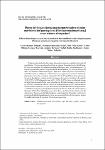Mostrar el registro sencillo del ítem
Efecto del faique (Acacia macracantha) sobre el valor nutricional del pasto guinea (Panicum maximum Jacq.) en un sistema silvopastoril
| dc.contributor.author | Romero Delgado, G. | |
| dc.contributor.author | Echevarría Rojas, M. | |
| dc.contributor.author | Trillo Zárate, F, | |
| dc.contributor.author | Hidalgo Lozano, V. | |
| dc.contributor.author | Aguirre Terrazas, L. | |
| dc.contributor.author | Robles Rodríguez, R. | |
| dc.contributor.author | Núñez Delgado, J. | |
| dc.date.accessioned | 2021-11-11T20:06:39Z | |
| dc.date.available | 2021-11-11T20:06:39Z | |
| dc.date.issued | 2020 | |
| dc.identifier.citation | Romero Delgado, Gelver, Echevarría Rojas, Mariano, Trillo Zárate, Fritz, Hidalgo Lozano, Víctor, Aguirre Terrazas, Lucrecia, Robles Rodríguez, Rafael, & Núñez Delgado, Jimny. (2020). Efecto del faique (Acacia macracantha) sobre el valor nutricional del pasto guinea (Panicum maximum Jacq.) en un sistema silvopastoril. Revista de Investigaciones Veterinarias del Perú, 31(1), e17562. Epub 31 de marzo de 2020.https://dx.doi.org/10.15381/rivep.v31i1.17562 | es_PE |
| dc.identifier.uri | https://hdl.handle.net/20.500.12996/5036 | |
| dc.description | Universidad Nacional Agraria La Molina. Escuela de Posgrado. Maestría en Producción Animal | es_PE |
| dc.description.abstract | El objetivo del estudio fue determinar la tasa de crecimiento y calidad nutricional del pasto Guinea (Panicum maximum Jacq) bajo un sistema silvopastoril con el árbol faique (Acacia macracantha). Se evaluaron dos épocas (lluviosa y seca) y tres tratamientos: (1) bajo la copa del árbol joven, (2) bajo la copa del árbol mediano y (3) fuera de la copa del árbol. Los árboles se clasificaron según el diámetro a la altura al pecho. El crecimiento y calidad del pasto se midió por el método de corte y separación y posterior análisis de laboratorio. La tasa de crecimiento osciló de 71.09 a 51.15 kg MS/ha/d, fuera y dentro de la copa de los árboles, respectivamente, en la época lluviosa. La proteína cruda varió de 10.58, 12.79 y 13.88% (época lluviosa) y 8.93, 10.26 y 11.99% (época seca) fuera de la copa del árbol, bajo la copa del árbol joven y bajo la copa del árbol mediano, respectivamente (p<0.05). El contenido de calcio en el pasto fue estadísticamente (p<0.05) superior bajo la copa del árbol mediano (0.23%) que fuera de la copa del árbol (0.20%) en la época lluviosa. El fósforo en el pasto varió significativamente (p<0.05) entre 0.72, 0.83 y 0.91% (época lluviosa) y 0.73, 0.87 y 1.06% (época seca), fuera de la copa de los árboles, bajo la copa del árbol joven y bajo la copa del árbol mediano, respectivamente. El estudio reveló que la presencia de árboles leguminosos (Acacia macracantha) dentro de los potreros mejora la calidad nutricional de la pastura Panicum maximum Jacq. | es_PE |
| dc.description.abstract | The aim of this study was to determine the growth rate and nutritional quality of Guinea grass (Panicum maximum Jacq) under a silvopastoral system with the faique tree (Acacia macracantha). The evaluation included two seasons (rainy and dry) and three treatments: (1) under the canopy of the young tree, (2) under the canopy of the mediumsize tree, and (3) outside the canopy of the tree. The trees were classified according to the diameter at chest height. The growth and quality of the grass were measured by the method of cutting and separation and subsequent laboratory analysis. The growth rate ranged from 71.09 to 51.15 kg DM/ha/d, outside and inside the tree canopy, respectively, in the rainy season. Crude protein varied from 10.58, 12.79 and 13.88% (rainy season) and 8.93, 10.26 and 11.99% (dry season) outside the tree canopy, under the young tree canopy and under the middle tree canopy respectively (p<0.05). The calcium content in the grass was statistically (p<0.05) higher under the middle tree canopy (0.23%) than outside the tree canopy (0.20%) in the rainy season. The phosphorus in the grass varied significantly (p<0.05) between 0.72, 0.83 and 0.91% (rainy season) and 0.73, 0.87 and 1.06% (dry season), outside the tree canopy, under the canopy of the young tree and under the canopy of the medium tree, respectively. The study revealed that the presence of leguminous trees (Acacia macracantha) within the paddocks improves the nutritional quality of the Panicum maximum Jacq pasture. | en_US |
| dc.format | application/pdf | en_US |
| dc.language.iso | spa | es_PE |
| dc.publisher | Universidad Nacional Mayor de San Marcos. Facultad de Medicina Veterinaria. Instituto Veterinario de Investigaciones Tropicales y de Altura | es_PE |
| dc.rights | info:eu-repo/semantics/openAccess | en_US |
| dc.source | http://www.scielo.org.pe/scielo.php?pid=S1609-91172020000100003&script=sci_arttext | es_PE |
| dc.subject | Acacia macracantha | es_PE |
| dc.subject | Panicum maximum | es_PE |
| dc.subject | Sistemas agropascicolas | es_PE |
| dc.subject | Pastizales | es_PE |
| dc.subject | Valor nutritivo | es_PE |
| dc.subject | Crecimiento | es_PE |
| dc.subject | Digestibilidad in vitro | es_PE |
| dc.subject | Evaluación | es_PE |
| dc.subject | Cultivo asociado | es_PE |
| dc.subject | Perú | es_PE |
| dc.subject | Pasto Guinea | es_PE |
| dc.subject | Faique | es_PE |
| dc.title | Efecto del faique (Acacia macracantha) sobre el valor nutricional del pasto guinea (Panicum maximum Jacq.) en un sistema silvopastoril | es_PE |
| dc.title.alternative | Effect of the faique (Acacia macracantha) on the nutritional value of guinea grass (Panicum maximum Jacq.) in a silvopastoral system | en_US |
| dc.type | info:eu-repo/semantics/article | en_US |
| dc.identifier.doi | http://dx.doi.org/10.15381/rivep.v31i1.17562 | es_PE |
| dc.subject.ocde | https://purl.org/pe-repo/ocde/ford#4.02.01 | es_PE |
| dc.publisher.country | PE | es_PE |
| dc.type.version | info:eu-repo/semantics/publishedVersion | en_US |


